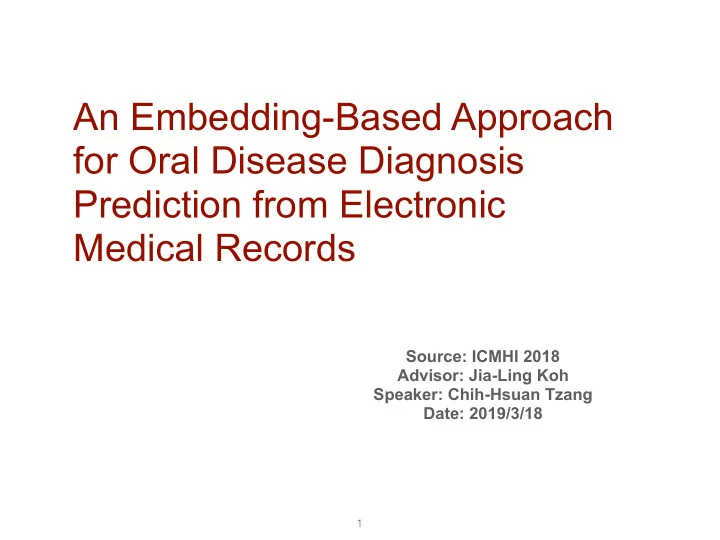

An Embedding-Based Approach for Oral Disease Diagnosis Prediction from Electronic Medical Records Source: ICMHI 2018 Advisor: Jia-Ling Koh Speaker: Chih-Hsuan Tzang Date: 2019/3/18 � 1
• Introduction • Method • Experiment • Conclusion � 2
• Introduction • Method • Experiment • Conclusion � 3
Introduction Motivation • EHRs have been a valuable medical asset that can be used to facilitate clinical decision making by discovering hidden knowledge and predicting diagnoses • Often fail to Capture the correlations inherent in patient clinical data. � 4
Introduction Goal • we intend to exploit the PKUSS data by exploring state-of-the-art AI technologies that can capture correlations hidden in the EMRs � 5
• Introduction • Method • Experiment • Conclusion � 6
Departments Method Pediatric Dentistry Oral and Maxillofacial Surgery Laser Dentistry Data Description: Emergency • 7208 PKUSS EMRs Oral Medicine • EMRs belong to the 11 departments Prosthodontics • Each record consist 6 parts. Geriatric Dentistry General Dentistry Orthodontics Periodontology Implant Dentistry Parts Chief complaints (C.C) family history (F .H.) History of present illness (HPI) Physical examination (P .E.) Past medical history (PMH) Diagnosis � 7
Learning Symptom and Diagnosis Method Feature extraction • Extract symptoms based on bigram from medical history C.C., HPI, PMH, and F .H. • Regular expression to match symptoms from P .E. � 8
Method Feature Extraction � 9
Method Learning the correlation � 10
Method Learning the correlation A EMR dataset: {( x i , y i )} m i =1 x i - Feature vectors x i = ( x (1) i , . . . , x ( n ) S a S b S c S d i ) ex. = (0, 1, 0 , 1) x 1 y i - Diagnosis y i ∈ {1,..., l } � 11
Method Learning the correlation i C ( symp n )) 𝖴 x i ⊙ C = ( x (1) i C ( symp 1 ), . . . , x ( n ) S a S b S c S d ex. = (0, 1, 0 , 1) x 1 C ( ⋅ ) ∈ ℝ k k k k k ( n × k ) k k k k x i ⊙ C � 12
Method W 1 Learning the correlation k k k k ( n × k ) × 1 k × 1 z 1 = W 1 ( x i ⊙ C ) + B 1 k × ( n × k ) k × 1 a 1 = tanh ( z 1 ) k × 1 � 13
Method W 2 Learning the correlation i V ( diag l )) 𝖴 y i ⊙ V = ( y (1) i V ( diag 1 ), . . . , y ( l ) k × 1 l × 1 z 2 = W 2 a 1 + B 2 l × k l × 1 ( l × k ) V ( ⋅ ) k k k k k y i ∈ {1,..., l } D 1 D 2 D 3 D 4 D 5 � 14
Method Learning the correlation Softmax: e ( x i C ) V [ j ] T − U ij o ij = ∑ l k =1 e ( x i C ) V [ k ] T − U ik x i C U ij = ∥ − V [ j ] ∥ 2 ∥ x i ∥ 1 � 15
• Introduction • Method • Experiment • Conclusion � 16
Experiment t × 100 ACC = N sum � 17
Experiment l ∑ Weighted _ R = α i R i i =1 l ∑ Weighted _ P = α i P i i =1 l ∑ Weighted _ F 1 = α i F 1 i i =1 TP Precision = TP + FP TP Recall = TP + FN F 1 = 2( P * R ) P + R � 18
Experiment K = p 0 − p e 1 − p e � 19
Experiment n i , j tf i , j = ∑ k n k , j | D | idf i = log 1 + | { j : symp i ∈ diag j } | tfidf i , j = tf i , j × idf i � 20
Experiment � 21
Experiment � 22
• Introduction • Method • Experiment • Conclusion � 23
Conclusion • Build the model by learning the both symptoms and diagnosis embeddings to predict the diagnosis. • Expressing the unique correlations that exist in the medical records. � 24
Recommend
More recommend